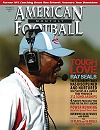Article CategoriesAFM Magazine
|
Father Figure – In his celebrated career, Houston’s Ray Seals became much more than a coach to many of his players.by: David Purdum© More from this issue Twenty-three years ago, Ray Seals decided to change his coaching legacy. It wasn’t going to just be about football anymore. Seals arrived at Madison High School (TX) in 1988 to find a program full of kids from low-income families. Some came to practice with no clothes; some hadn’t eaten. His players were foul-mouthed and disrespectful. They weren’t college material. “I said right then that when I became head coach, that wasn’t going to happen to my kids,” said Seals. In June, after 46 years coaching in the Houston Independent school district, the last 23 at Madison High School, Seals hung up his whistle, retiring with 212 wins, 21 playoff appearances and a dozen coach of the year awards, including the inaugural NFL Don Shula Coach of the Year Award. That honor earned him a trip to the Super Bowl. But those....The full article can only be seen by subscribers.
|
|
|||||||
| HOME |
MAGAZINE |
SUBSCRIBE | ONLINE COLUMNISTS | COACHING VIDEOS |
Copyright 2025, AmericanFootballMonthly.com
All Rights Reserved





